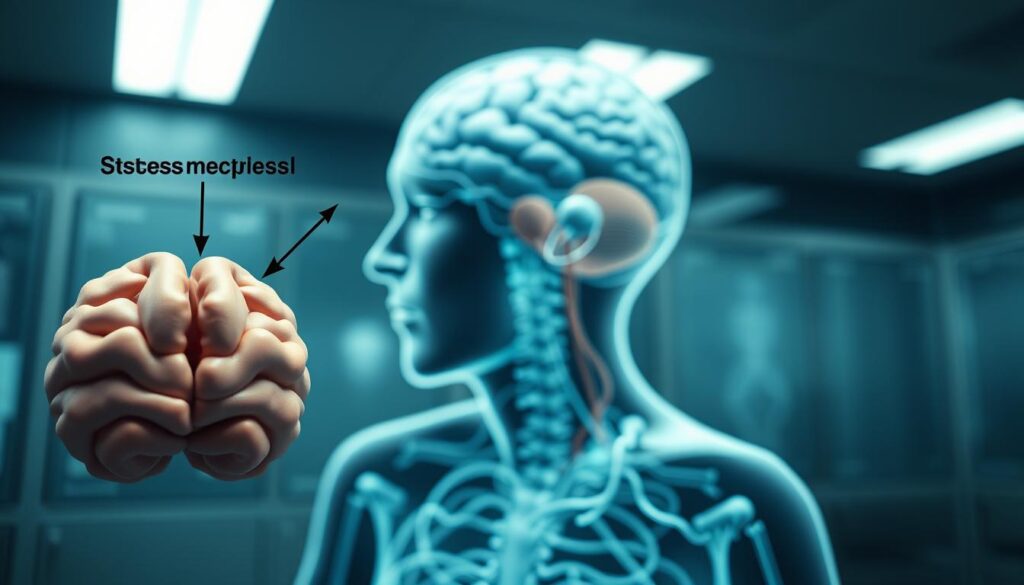Carl Jung once observed: “What you resist not only persists but will grow in size.” This insight perfectly frames our relationship with life’s pressures – not as enemies to defeat, but as signals guiding us toward growth. Modern research from the American Psychological Association reveals that 77% of Americans experience physical symptoms caused by stress, while 73% report emotional impacts.
Your body speaks first when tension mounts. Racing heartbeats, stiff shoulders, or digestive discomfort often appear before emotional responses like irritability or mental fog. The National Institutes of Health confirms these physical warnings exist to protect us – when heeded, they become powerful allies in maintaining wellness.
This guide reveals practical methods used by mental health professionals and peak performers alike. You’ll discover how simple daily habits can transform overwhelming anxiety into focused energy. From neuroscience-backed breathing patterns to time-tested cognitive strategies, these tools help create lasting emotional resilience.
Key Takeaways
- Physical signals like headaches and muscle tension act as early warning systems
- Emotional responses often follow physical stress manifestations
- Research-backed methods improve both mental and physical wellness
- Small daily habit changes create cumulative protective effects
- Personalized strategies work better than one-size-fits-all approaches
- Professional guidance enhances self-directed practice
Understanding Stress and Its Impact
Your pounding heartbeat during a work deadline isn’t random—it’s ancient survival coding. Stress acts as the body’s built-in alarm system, triggering the fight-or-flight response when facing challenges. This biological mechanism floods your system with cortisol, sharpening focus during short-term crises but causing wear if constantly activated.

What Is Stress?
Stress emerges when demands exceed your perceived ability to cope. It’s not inherently negative—planning a wedding or starting a new job can create positive tension that fuels growth. Problems arise when this state becomes chronic, disrupting physical and emotional balance. A 2022 survey found 76% of Americans experience monthly stress symptoms, proving its widespread role in modern life.
Recognizing Physical and Emotional Symptoms
The body often signals distress before the mind catches up. Common physical warnings include:
| Physical | Emotional | Behavioral |
|---|---|---|
| Headaches | Irritability | Social withdrawal |
| Muscle tension | Constant worry | Appetite changes |
| Digestive issues | Feeling overwhelmed | Reduced productivity |
These signs frequently appear in daily things like workplace conflicts or family responsibilities. A project manager might develop neck pain before acknowledging deadline pressure, while a parent could snap at loved ones when juggling too many tasks. Recognizing these patterns creates opportunities for early intervention.
Proper support—whether through loved ones or professional resources—helps reframe stress responses. When you identify racing thoughts before bed or clenched jaws during meetings, you gain power to choose healthier reactions. This awareness forms the foundation for all effective coping strategies.
Identifying the Causes of Chronic Stress
Mounting pressures rarely stem from single events. Chronic tension typically develops through repeated exposure to demanding situations that chip away at mental reserves. Research shows 64% of U.S. adults faced adverse childhood experiences—early problems that often resurface as adult stressors.

Daily Pressure Points
Modern life creates perfect conditions for prolonged strain. Financial worries, caregiving duties, and health concerns act like overlapping waves—each manageable alone, but overwhelming when combined. A teacher might handle classroom challenges, but adding aging parent care and mortgage payments creates a tipping point.
Marginalized communities often face compounded difficulties. Systemic barriers like income inequality or discrimination create unique situations where everyday problems feel magnified. Recognizing these patterns offers the first way to break the cycle.
Building resilience starts with mapping personal triggers. Common culprits include:
- Unrealistic work deadlines draining cognitive resources
- Relationship conflicts eroding emotional safety
- Chronic pain disrupting sleep patterns
Each stressor feeds others in subtle ways. Missed promotions might strain marriages, while sleep deprivation weakens immune responses. By tracing these connections, you gain power to address root causes rather than symptoms—a crucial way to foster lasting resilience.
Actively Manage Stress Through Daily Practices
Daily routines shape more than schedules—they build mental armor against life’s pressures. Neuroscience reveals that consistent patterns rewire neural pathways, creating automatic defenses against tension. A structured day acts like scaffolding, supporting both body and mind through predictable rhythms.

Mindfulness and Self-Care Techniques
Start small: five minutes of morning breathing sets a calm tone. Try the “5-4-3-2-1” grounding method—notice five visible objects, four textures, three sounds, two scents, one taste. This simple trick anchors awareness during chaotic moments.
Keep a pocket-sized gratitude list. Writing three positive observations each day trains the mind to spot joy. Evening reflection sessions work best—pair them with herbal tea for enhanced relaxation.
Incorporating Exercise and Movement
Movement breaks boost cognitive function better than caffeine. A 15-minute walk after meals improves digestion and mental clarity. For busy households, family dance parties turn fitness into bonding time.
Pair physical activity with sleep hygiene. Evening yoga flows prepare the body for deeper rest—essential for emotional balance. Studies show regular exercisers fall asleep 55% faster than sedentary individuals.
Involve loved ones in routine-building. Shared Sunday meal preps or group stretching sessions create collective accountability. When others participate, healthy habits stick better—research confirms social support doubles habit success rates.
Practical Techniques to Reduce Stress
Morning sunlight filters through your kitchen window as you sip tea—a moment of peace before daily demands resume. These intentional pauses form the foundation of effective tension relief. Research confirms simple, consistent practices yield greater long-term benefits than occasional intensive efforts.
Breathing Exercises and Relaxation Methods
Your breath acts as a built-in reset button. Try diaphragmatic breathing before important meetings: inhale deeply through the nose for 4 counts, hold for 7, exhale through pursed lips for 8. This triggers the body’s relaxation response within 90 seconds.
Effective techniques vary by individual needs:
| Method | Best For | Duration |
|---|---|---|
| Box Breathing | Focus enhancement | 5 minutes |
| Alternate Nostril | Emotional balance | 3 minutes |
| 4-7-8 Pattern | Sleep preparation | 2 cycles |
Pair these with progressive muscle relaxation—tense/release muscle groups from toes upward. Studies show combining movement with breathwork increases benefits by 40%.
Creating a Calming Daily Routine
Structure liberates mental energy. Begin with 15-minute nature immersion each morning—water plants or watch birds. Neuroscience reveals natural light exposure within 30 minutes of waking regulates cortisol levels.
Build micro-pauses into your schedule:
- Post-lunch walks around the block
- Five-minute stretching sessions every 90 minutes
- Evening digital detox hours
Weekend activities matter too. Schedule nature walks or gardening sessions—activities requiring physical engagement without mental strain. A 2023 University of Michigan study found participants who spent 10 minutes daily outdoors reported 28% lower stress levels.
Understanding personal causes helps tailor these methods. Track tension patterns for three days—note when and why symptoms appear. This awareness allows customized solutions rather than generic advice.
Healthy Lifestyle Choices for Better Mental Health
The vibrant colors of fresh berries in your morning bowl do more than please the eye—they fuel cognitive firepower. What you eat directly shapes mental clarity and emotional stability, acting as either armor or ammunition against life’s pressures.
Balanced Diet and Energy-Boosting Foods
A nutrient-rich diet works like daily maintenance for your brain. Studies show Mediterranean-style eating patterns—rich in fish, nuts, and leafy greens—reduce depression risk by 33%. These foods supply omega-3s and antioxidants that combat inflammation, a key contributor to mood problems.
Think of food choices as short walks for your metabolism. Just as a 10-minute stroll boosts circulation, swapping processed snacks for walnuts or blueberries provides immediate cognitive benefits. Busy schedules needn’t derail progress—pre-cut veggies or hard-boiled eggs make grab-and-go solutions.
Consider these evidence-backed strategies:
- Pair complex carbs with proteins for sustained energy (e.g., apple slices with almond butter)
- Limit afternoon caffeine to prevent sleep disruption—a common stress amplifier
- Track meals in a food journal to identify mood-food connections
Regular physical activity, even in micro-doses, enhances these effects. A lunchtime walk around the block increases blood flow to the brain while providing perspective-shifting breaks. For those seeking deeper transformation, explore natural ways to enhance mental clarity through combined nutritional and mindfulness practices.
When chronic stress creates digestive problems or brain fog, dietary adjustments often bring relief. Fermented foods like yogurt rebuild gut biodiversity—critical since 90% of serotonin gets produced there. Small tweaks create compounding benefits, proving every mindful bite strengthens mental resilience.
Time Management and Setting Boundaries
Imagine your calendar as a garden—without pruning, it becomes overgrown and chaotic. Strategic planning helps cultivate productivity while protecting mental space. Studies show workers who set clear boundaries experience 42% less work-related pressure.
Prioritizing Tasks and Delegating Responsibilities
Start by identifying non-negotiable priorities. The Eisenhower Matrix offers a proven framework:
| Quadrant | Example | Action |
|---|---|---|
| Urgent & Important | Project deadline | Do immediately |
| Important Not Urgent | Exercise routine | Schedule |
| Urgent Not Important | Some emails | Delegate |
| Not Urgent/Important | Social media | Eliminate |
Effective delegation begins with honest self-assessment. Can someone else handle routine reports? Could a neighbor share school pickup duties? Freeing up 2-3 hours weekly creates breathing room.
Set communication boundaries to prevent burnout. Try these tactics:
- Use auto-replies after work hours
- Batch-check emails 3x daily
- Say “I need to consult my calendar” before committing
When unexpected issues arise—a sick child or server crash—return to core priorities. Reschedule less critical tasks rather than sacrificing sleep. Remember: Stress management isn’t about perfection, but adaptable systems.
Building a Resilient Mindset
Your morning coffee cools as you scroll through emails—a modern ritual where thoughts shape reality. How you interpret events determines whether challenges make feel empowering or overwhelming. This mental flexibility turns roadblocks into stepping stones.
Reframing Negative Thoughts
The Mayo Clinic emphasizes: “Seeing setbacks as temporary rather than permanent changes outcomes.” Cognitive restructuring works like mental software updates—replacing “I can’t handle this” with “I’ve solved harder problems before.”
| Negative Thought | Reframed Perspective | Impact |
|---|---|---|
| “This will ruin everything” | “This tests my adaptability” | Reduces panic |
| “I’m not good enough” | “I’m growing through this” | Boosts confidence |
| “Why does this always happen?” | “What can I learn here?” | Encourages solutions |
Combining physical mental strategies amplifies results. Deep breathing during tense meetings lowers heart rates while affirming “I’m capable” strengthens neural pathways. Studies show this dual approach helps 68% of people navigate stressful situations more effectively.
Embracing Gratitude and Positivity
Gratitude journals do more than list blessings—they rewire attention networks. Try these evidence-backed methods:
- Nightly reflections on three specific positives
- Texting appreciation notes to colleagues
- Mindful savoring of pleasant moments
When stressful situations arise, recalling past triumphs can make feel anchored. A teacher might remember former students’ successes when facing classroom challenges. This practice proves particularly effective—research indicates regular gratitude exercises reduce anxiety symptoms by 31%.
While stress may feel unavoidable, perspective determines its weight. Viewing difficulties as skill-building opportunities transforms how challenges make feel. As one executive shared: “Now when crises hit, I ask—what strength is this situation developing?”
Enhancing Social Support and Community Connections
Shared laughter during a neighborhood barbecue does more than lift spirits—it strengthens biological defenses. Studies reveal that positive social interactions boost oxytocin levels, reducing blood pressure and inflammation markers linked to chronic conditions.
Building Meaningful Relationships
Strong social ties act as shock absorbers for life’s bumps. A 2023 APA report shows people with reliable friends experience 34% fewer stress-related health issues. These bonds don’t require grand gestures—consistent small moments create lasting impacts.
| Activity | Benefit | Frequency |
|---|---|---|
| Weekly family dinners | Strengthens emotional safety nets | 3-4x monthly |
| Daily check-in texts | Maintains connection rhythms | Every day |
| Community volunteering | Expands support networks | 1-2x weekly |
Simple every day actions foster resilience. Walking with a coworker or sharing recipes with neighbors builds trust. These interactions make feel valued while improving physical health through reduced cortisol levels.
For those rebuilding social ties, established support networks offer structured ways to connect. Book clubs or fitness groups provide built-in conversation starters, easing social anxiety.
Quality matters more than quantity. One heartfelt conversation often makes feel more supported than five superficial chats. Prioritize relationships that energize rather than drain—this selectivity directly impacts physical health outcomes and emotional stamina.
Long-Term Stress Management Strategies
The glow of your bedside clock at 2 AM tells a story—not just of sleeplessness, but of patterns needing attention. Sustainable stress reduction requires consistent tracking and adaptation. A 2023 health report from Johns Hopkins revealed that people who review their coping strategies monthly experience 37% fewer stress-related health problems.
Tracking Patterns for Lasting Change
Weekly self-assessments help identify what’s working. Try this three-step process:
| Method | Frequency | Benefit |
|---|---|---|
| Sleep journaling | Daily | Reveals insomnia triggers |
| Stress scale ratings | 3x weekly | Shows progress trends |
| Habit audits | Monthly | Highlights effective techniques |
CDC research confirms those who sleep better handle challenges 42% more effectively. Try cooling your bedroom to 65°F—this mimics natural body temperature drops for deeper rest. Pair with 20-minute afternoon walks to regulate circadian rhythms.
When health problems persist despite efforts, consult professionals. Many clinics offer free health report analyses that help identify hidden issues like nutrient deficiencies. As one nurse practitioner notes: “Annual stress checkups should be as routine as dental cleanings.”
Adapt strategies using proven stress management techniques that evolve with life changes. Remember—effective ways to deal stress grow with you, like tailored workout plans adjusting to fitness levels.
Conclusion
Your journey toward balance begins like sunrise—gradual, inevitable, and uniquely yours. This guide has illuminated how small daily choices shape mental fortitude. From mindfulness practices that work with your body’s rhythms to social connections that reinforce resilience, each strategy offers a stepping stone to lasting well-being.
Research confirms that those who prioritize time for self-care experience 42% fewer health disruptions. Whether through breath-focused pauses or nutrient-rich meals, consistent effort creates compounding benefits. Studies show even brief daily mindfulness sessions rewire neural pathways within eight weeks.
Revisit this information as life evolves—what serves you today might shift tomorrow. Many find keeping a progress journal helps track patterns and celebrate growth. For deeper insights, explore how holistic approaches strengthen both mind and through integrated techniques.
True management of life’s pressures isn’t about elimination but transformation. Every challenge faced with intention becomes fuel for personal evolution. Remember: The people who thrive aren’t stress-free—they’ve simply mastered turning turbulence into forward motion.
FAQ
How can I recognize if stress is affecting my health?
Physical signs like headaches, fatigue, or digestive issues often accompany emotional symptoms such as irritability or difficulty concentrating. Tracking these patterns in a journal helps identify stress-related health problems early.
What daily habits reduce chronic stress effectively?
Consistent mindfulness practices—like meditation—paired with 30 minutes of brisk walking or yoga improve resilience. Combining these with a nutrient-rich diet stabilizes energy levels and supports mental health.
Can breathing exercises really calm the nervous system?
Yes. Techniques like box breathing (inhale-hold-exhale-hold for 4 counts each) activate the parasympathetic nervous system, lowering heart rate and blood pressure within minutes. Pair them with nature walks for enhanced stress relief.
How does social support improve stress management?
Strong connections with family or friends release oxytocin, which counters cortisol production. Regular check-ins or shared activities build emotional safety nets, making challenging situations feel more manageable.
What foods boost mental health during stressful periods?
Omega-3-rich foods (walnuts, salmon) and magnesium sources (spinach, dark chocolate) regulate stress hormones. Vitamin C from citrus fruits also reduces cortisol spikes, while staying hydrated maintains cognitive clarity.
Why does time management lower stress levels?
Prioritizing tasks using tools like the Eisenhower Matrix reduces decision fatigue. Delegating responsibilities and setting digital boundaries prevent burnout, freeing mental space for restorative sleep and self-care.
How do I reframe negative thoughts under pressure?
Practice cognitive restructuring by asking: “Is this thought factual or fear-based?” Replace catastrophizing phrases with balanced perspectives—e.g., “This is tough, but I’ve handled similar problems before.”
When should someone seek professional help for stress?
If symptoms persist for weeks—like insomnia, appetite changes, or loss of interest in activities—consult a therapist. Platforms like BetterHelp or Headspace offer accessible mental health support for developing coping strategies.




























































